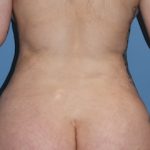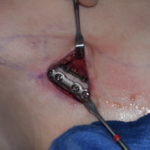Background: Unlike skull reconstruction elective aesthetic skull augmentation has a much more limited history. Due to an historic low demand and limited options for performing it building up areas of the skull has relied on the use of bone cement, mainly PMMA. (acrylic) By history such bone cements were initially made for reconstruction of skull defects which have well defined borders. Like concrete it is a separate liquid and powder which is mixed intraoperatively to create a putty which hardens in less than 12 minutes. Thus it is easy to see how this putty application into a skull defect can be easily applied, contoured and allowed to harden.
When PMMA bone cements are used as an onlay skull augmentation material, however, it has some very different application issues which impact its aesthetic effects. The most obvious plication issue is incisional access. In skull reconstructions there is always a larger scalp incision so wide open exposure exists. But the use of such large scalp incisions is rarely permitted by the patient in aesthetic skull contouring. As a result limited incision applications techniques have been developed which basically consists of pushing through the initial putty mixture into a created subperiosteal scalp pocket and then blidndluy molding it externally as it sets.
While this aesthetic bone cement skull augmentation technique can be effective in some cases, it has multiple limitations. The most significant one is also the least obvious….an initial soft putty mixture has limited to no ability to push the tight scalp outward. The tight scalp pushes back and flattens the soft material which is magnified by externally molding it by hand. Thus the thickness of the augmentation and extent of surface area coverage is going to be limited.
Another PMMA bone cement limitation is getting an exact shape of the desired skull contour. Other than some gentle limited rounding there is no way to get a very specific controlled skull augmentation even if one has wide open access…as the following case will illustrate.






Bne cement, unlike its name, does not bond to the bone at least in PMMA composition. The body simply views it as another type of implant and encapsulates it. Given its numerous reshaping limitations and the more contemporary and versatile aesthetic skull augmentation technique of custom skull implant designing improved skull reshaping results are now possible.
Key Points:
1) PMMA bone cements provide inadequate skull augmentations when significant onlay volume additions are needed.
2) A custom skull implant provides more augmentation volume in a controlled predetermined shape
3) The prior bone cement provided some scalp expansion which permit more implant volume to be added secondarily.
Dr. Barry Eppley
World-Renowned Plastic Surgeon








